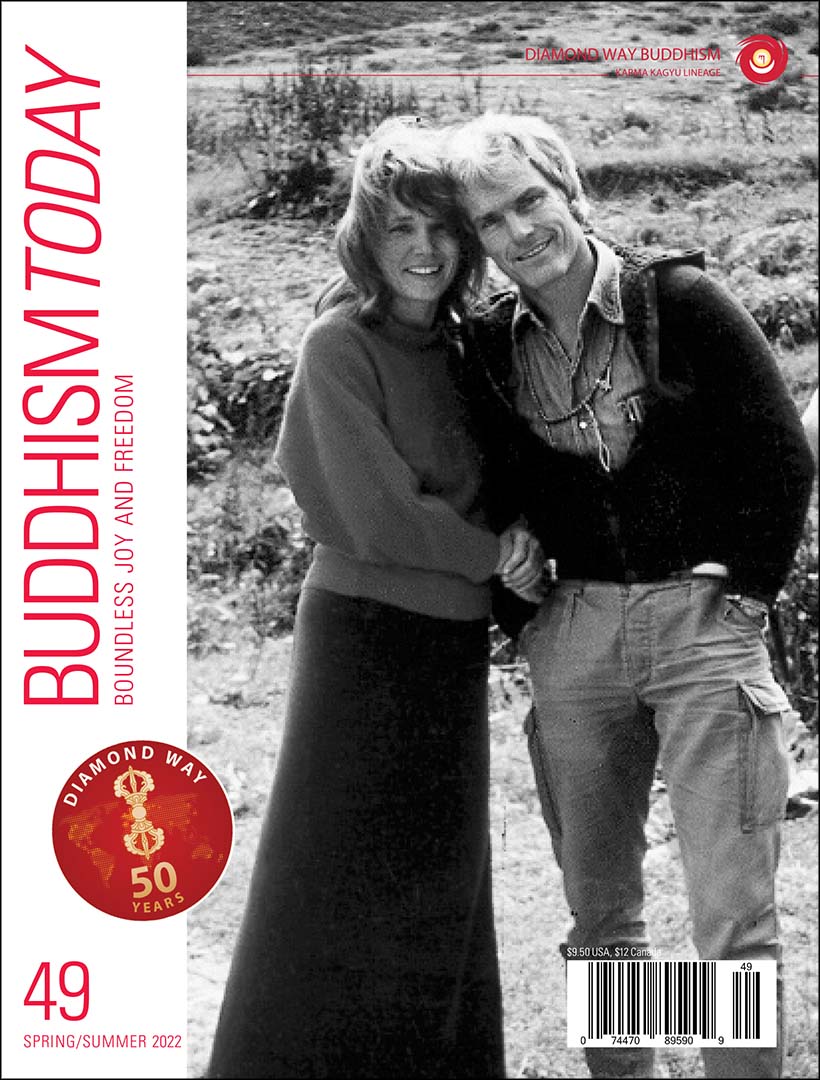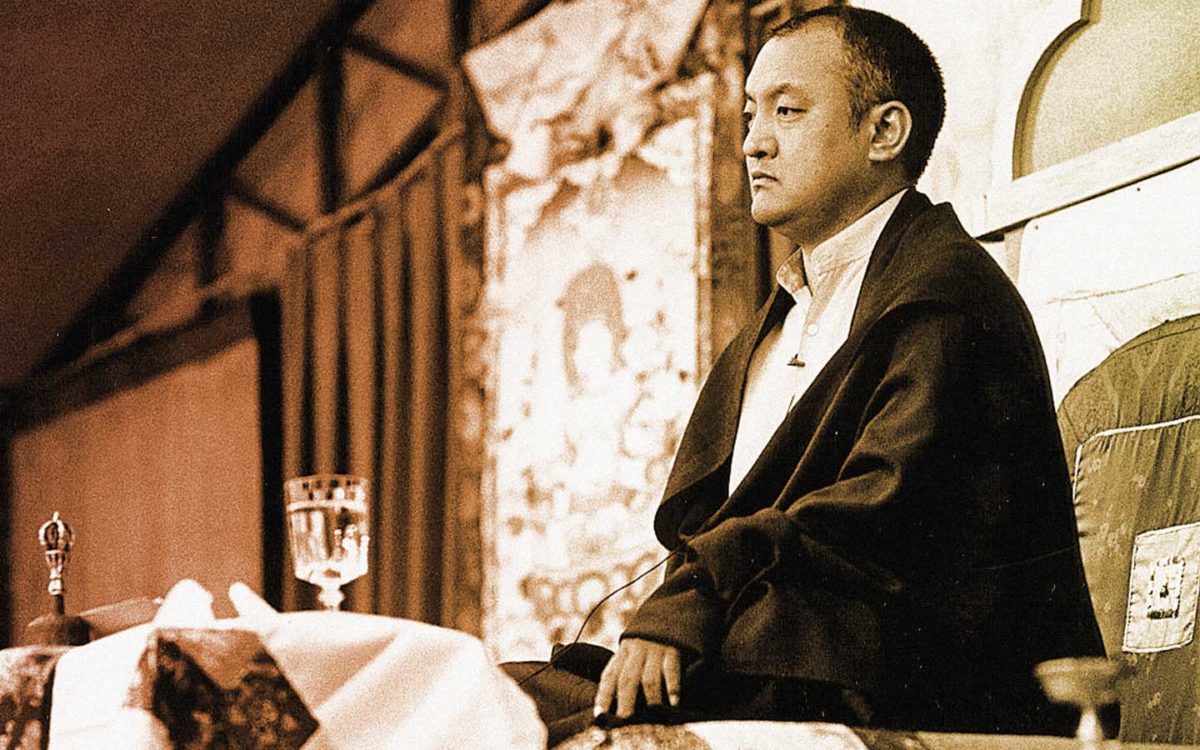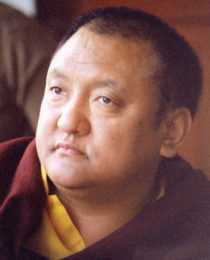Meditation: Planting Seeds in the Mind
by Shamar Rinpoche | Issue 34
This is a transcription of a question and answer session that H.H. Kunzig Shamar Rinpoche held at the Diamond Way Buddhist Center in San Francisco, CA, in the summer of 2006.
Question: What would you say to someone who is trying to understand more about Buddhism and how it relates to Western society?
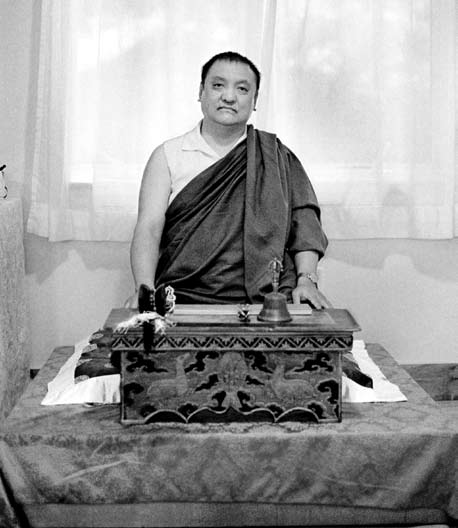
Shamar Rinpoche: Buddhism teaches the nature of the truth, which anyone can understand. It teaches human beings how to develop their qualities.
Before he became the Buddha, Shakyamuni was a prince, the son of a wealthy king in India. While he had everything anyone could want, he was not satisfied. He realized that happiness could not be obtained from material things, for they cannot satisfy the mind’s craving. He began exploring why that was the case. He saw many people with problems and a lot of suffering. He saw people suffering from old age. He saw women suffering from childbirth. He saw people dying, and others crying for the dead. He saw that this was inevitable.
Buddha discovered that happiness must be developed in the mind, and that ultimate happiness is not achieved by being self-centered. Self-clinging is the cause of all problems. When you discover this root, you will discover the cause. Aggression is caused by agitation. Agitation is caused by self-clinging—it is cause and effect. Cause and effect continually increase. The main root is this mistaken mind, the mind of self-clinging. It should be tamed through developing the peaceful nature of mind. This is the remedy to cure mind’s confusion. This is what Buddha discovered.
In the society at Buddha’s time, techniques for cultivating peace of mind already existed. He learned these methods and accomplished the meditations, achieving the results of each in progression. He was very intelligent, going beyond what was practiced at the time and developing his own genuine meditation, until finally he became Buddha. The word buddha means “blooming up” or “fully developed.” After he achieved this profound result, he taught his students how to develop happiness. The disciples who followed Buddha and practiced his teachings became accomplished in the same way he did. Buddha’s teaching lineage developed through great practitioners beginning at that time and continuing through today.
Living beings don’t understand the truth, the truth of suffering. Where does it come from? Suffering is not a punishment that somebody decreed. Buddha discovered that the truth of the cause of suffering is self-clinging. Once you cling to the self, then you push against anything that threatens the self, and all problems develop from there. What are the remedies? If you know the true cause of suffering, it is easy to find the remedy. Buddha called this the truth of the path. Then you achieve the result: freedom from suffering and liberation from self-clinging.
Buddhist philosophy follows this natural law. It is not really a religion. Around the world, the word religion means worshiping something, a superior being, somebody above you. This is not the way of Buddhism. Buddha’s teachings follow the natural way of how things truly are.
Question: Can you explain a little bit more about self-clinging?
Shamar Rinpoche: Self-clinging is when the mind clings to a self. You get angry when something happens that goes against this self, against what you like. Clinging to a self is very negative and brings grasping and attachment to what we desire. Unhappiness is the result. The mind is confused, so there is a lot of agitation. This all comes from ignorance. The agitation is not fundamental, but it has its effects. All living beings experience this self-clinging. It is a feeling of “me” and a strong grasping to that. If you search for a “me” or a “self,” you will not find it; therefore, it does not really exist. But we mistakenly establish it as existing in the mind.
Question: I’ve heard you talk about the practice of the Thirty-Five Buddhas, and you have also emphasized working with shinay meditation. How do we resolve making the choices about which meditations to practice?
Shamar Rinpoche: The Kagyu school is one of the lineages of Buddha’s teachings. Buddha’s teachings are like the ocean, and Kagyu teachings are one of the rivers. We cannot teach everything at one time, so we must select suitable teachings for Westerners. When Lama Ole and Hannah Nydahl were in Rumtek in 1968 studying Buddhism, H.H. the 16th Gyalwa Karmapa Rangjung Rigpe Dorje taught them the practice of the Karmapa’s Guru Yoga, the Four Foundational Practices, and the Jewel Ornament of Liberation, written by Gampopa. After they were trained, Karmapa told Lama Ole to teach in the West. We have been holding the lineage of the Kagyu school for practitioners everywhere.
The Thirty-Five Buddhas is a selection from the general Buddhist teachings, a teaching of the Buddha. All four schools—Kagyu, Gelug, Nyingma, and Sakya—follow these teachings and do this practice, as do many lamas in Tibet. Now, I am recommending that many people in the West also do this practice. You can learn as many Buddhist teachings as you like—you are not limited to the Kagyu school. If you have the time and energy, it is good to learn as much as you can of Buddha’s teaching.

Question: Could you talk about the importance of the lama in one’s practice?
Shamar Rinpoche: Lama means teacher, a qualified teacher, not some kind of spiritual ruler. Lamas should teach well; and students must listen and study well in order to follow their instructions.
There are two types of teachers: an enlightened master and a good lama. An enlightened master, like Milarepa, can generate great blessings. One makes supplication to Milarepa in order to receive the power of his blessings. Since Milarepa was enlightened, he made wishing prayers for the benefit of all beings. An enlightened teacher or bodhisattva has the capacity to generate great blessings toward all sentient beings because of his or her absolute and genuine compassion. When bodhisattvas achieve enlightenment, all the wishes they have made previously for sentient beings come to fruition.
It can be hard to find the time and money to go to a course or meditation retreat. To maintain a strong practice, how frequently do you think we should take the time for this, for instance going to Lama Ole’s phowa courses?
Lama Ole teaches phowa, the practice for transferring one’s mind to the pure land of Amitabha after this life ends. You have to learn that from him. So, the more time you can spend to learn that teaching, the better it is for you. After you learn it very well, then it is okay that you don’t go all the time. If you learn everything completely in one day, it’s enough (laughter). But no, once is not enough.
Question: What’s the best way to dissolve the feeling that we are separate from everything else, to dissolve our attachment?
Shamar Rinpoche: Meditation is the remedy. Suffering occurs in the mind because of our attachment. All suffering that appears in the outer world is on the surface. Real suffering is in the minds of living beings. When you overcome mind’s suffering, all suffering is gone. It is not “you” suffering anymore. Buddhism teaches that the fundamental suffering of mind is very subtle. It lies passively hidden beneath a great deal of confusion. The suffering that we most often think about is not this fundamental suffering. It is this mistaken mind, the root of it all, that invites suffering. So how does this feeling of “me” make so much trouble? Even a little bug has that feeling of “me” or “I.” That mind grasping onto itself, clinging to itself, is the root of all our problems. The goal of meditation is to free this mind that grasps on to itself as an ego. First, meditation calms the totally confused and agitated mind, in order to be able to concentrate gently. If you are aggressive and push hard in your meditation, you can create more problems. Meditation is the technique of resting in the true nature of mind.
Shinay meditation is developed in accordance with mind’s nature. If you apply too much effort, then you will suffocate, and the mind will not accept what you are doing immediately. Therefore, begin gently with shinay practice. The progression of shinay practice is well-conceived. When mind has completely accepted this shinay technique, then mind is tamed. You free your mind from being agitated, from being busy this way. Then, mind can utilize its very sharp faculties and develop insight into mind’s nature. When meditation is very sharp and clear, mind can realize its true nature (i.e., a mind that is not confused). So, that is how you progress through stages in meditation. Meditation is the real cure for suffering, through dissolving self-centered confusion and grasping.
Question: I’m fairly new to Buddhism. I have a background in Christianity, so I’m curious how Buddhists view the Christian world.
Shamar Rinpoche: Christianity is not centered on meditation, as is the case in Buddhism. In Christianity there is a contemplative state, but the focus is still on praying to an outer god as a savior. God is the savior of human beings. I think in general Christianity believes that human beings cannot save themselves. Buddhists say that all living beings have the potential for self-liberation. There is no difference in this sense between humans and animals; each has a mind. Only the physical form is different, with animals having less intelligence and facility. All beings suffer, and they all can be liberated.
Question: Sometimes I feel that animals are less neurotic than humans, because humans are either constantly in the past or in the future, never in the present moment. And animals never worry about their future or think about their past, right?
Shamar Rinpoche: Everything depends on wisdom. Liberation means to eliminate ignorance. A pleasant, innocent animal like a koala bear is just sleeping. But their ignorance is continuous. It’s a matter of wisdom. Human beings, yes, are very materialistic. But, they have the capacity to know (better capacity than koala bears) and to learn. Human life has better faculties and therefore carries a chance for liberation. It is not that we are prejudiced against animals; rather, humans have more capacity. Therefore, it is humans’ duty to serve animals, because we are more aware. So in your life, serve humans and animals.
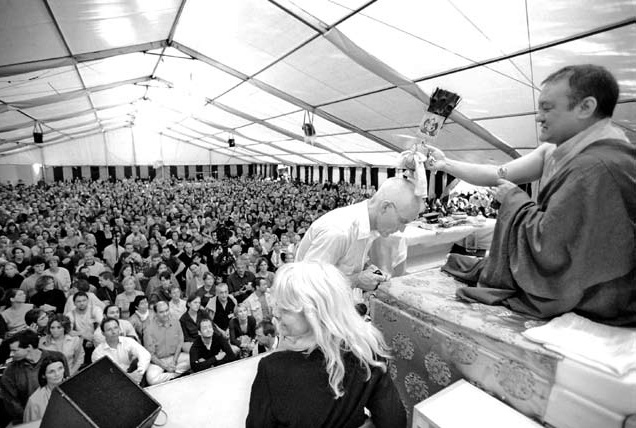
Question: If, in our lives as humans, we fail to make the world better, will we return to an animal state?
Shamar Rinpoche: It is very possible. Animals are one of the realms of suffering. There are many living beings in the hot fire under the earth, and there are many beings in the cold ice also. Everything is possible. It is a good question because it invites a study of the subject of karma. Karma is a kind of mental event. Mind is like a field, and all the activities of mind are like planting seeds. Everything you see now, all the physical forms, are illusions that developed from the previous actions of mind. So, these karmic seeds are creators of our experience.
Dreams are created by small karmic seeds. Dreams are shallow and unstable, not like a waking experience. There is no difference in essence between dreams and our waking lives. The only difference is that small karmic seeds create unstable illusions; you just dream them, and they disappear.
Strong karmic seeds planted in the field of mind are connected to strong emotion and self-clinging. They create one big dream, this human life. We have earth and physical forms in which we dwell. We can communicate with one another. One dreamer interacts with another dreamer, and they experience each other. This is a deeply established big dream, but it is impermanent and will one day disappear, at the time of death. So, when this does disappear, that is the time when another strong karmic seed will develop and create another peak illusion of the next life. But, who knows of what? It is very uncertain whether we can avoid unfortunate births, those in which very intense suffering arise.
Bardo is this period after one life has ended and before another has started, when many karmic seeds can ripen. So the most recent or most powerful seed that arises will produce its result, creating animal, human, or other forms that can develop from mind. It all depends on your habitual patterns.
Question: So, this is the very reason we practice?
Shamar Rinpoche: Yes. That’s why prostrations to the Thirty-Five Buddhas are like therapy for the mind. You’re planting a lot of good karmic seeds in the mind with mandala recitation.1 These are the methods. This is how to accumulate a lot of completely pure and positive seeds in the mind, in your basic consciousness. This always produces good dreams. It gives you the opportunity to be free from samsara.2 Before you get completely free from samsara, you need good dreams. Human life has the potential for enlightenment—it is easier through good dreams.
Question: I live in the heart of the city, and it seems that in big cities there is a lot of suffering. Every day when I drive home, somebody is knocking on my window, asking for money. And you realize you can give every single one of them ten dollars, but it wouldn’t really reduce their suffering. Do you have any advice?
Shamar Rinpoche: Generosity practice is the best thing. It is the first paramita. The Six Paramitas are steps toward enlightenment. Paramita means accomplishment. Generosity is the main practice that can develop all other merit. This doesn’t mean that in order to accomplish the generosity practice, one should make this whole realm free from beggars.
Dedicate as much as you can to all beings—this is generosity practice. So, if you have little capacity to help the beggars, make good wishes for them with the right attitude. If you can do this, you will have genuine compassion. And that will help develop your capacity to eventually help all beings. So, generating good wishes is the best thing you can do. Giving but expecting gratitude in return is not pure generosity; it is much better to make a wish for them.
Question: You spoke earlier about the vast number of teachings available. Wouldn’t it distract the practitioner to open up to the many other teachings, even if they are good?
Shamar Rinpoche: Yes. Then you should know how to orient your practice, to bring everything to the focal point. Bring everything you learn into one practice, developing bodhicitta.3
Can you say something about expectations? Even in meditation we expect something.
Expecting a result is a kind of unnecessary pressure. So, try to avoid that. It doesn’t serve your meditation.
Question: I do the Guru Yoga Meditation on the 16th Karmapa. In the meditation, we visualize him and ask for his blessing. Since the 16th Karmapa reincarnated as the 17th Karmapa, can they both be there?
Shamar Rinpoche: This practice is not connected to the physical form at all. The vision of the 16th Karmapa is not separate from the 17th now or the 1st Karmapa from the past. Using the wisdom body of Karmapa is a method of receiving initiation to ripen the body-speech-mind qualities. So, it is not that you are focusing on another being and trying to draw his attention to you. This is a wisdom image from which you’re receiving an initiation. It is not a human person to whom you are calling for help.
Question: The evenings that I do the Guru Yoga Meditation on the 16th Karmapa, I have trouble sleeping. Is there a remedy for this?
Shamar Rinpoche: Don’t be so tense. Just try to use less effort and relax during meditation. When you concentrate in meditation, like when you visualize Chenrezig,4 it is just concentration. At that time, it is very important not to apply so much effort. Just be gentle with it and let it be more natural. If you apply a lot of effort, then you are artificially creating something. But energy is required. If you relax too much, then you will become drowsy. So, when you are sleepy, you should try to raise your energy. If you are visualizing, raise the image higher.
Meditation is like weaving. If it’s too tight or too loose, the cloth will be uneven. So, with meditation you have to find the balance. Too much effort creates agitation. If you relax too much, you will fall asleep. Concentrate gently; then it becomes more natural. This is the same when watching the breath during shine, or when doing Ngöndro or yidam visualization.
The Four Foundational Practices, or Ngöndro,5 are designed to flush out all the negative karma and store a lot of good causes in the mind, as in Mandala practice. Until you are fully enlightened, all your future lives are the ones in which you can help limitless sentient beings. These abilities and powers depend on your accumulation of merit. Even one virtuous thought can produce limitless power to liberate all sentient beings. One thought. That is why you first must take the Bodhisattva Promise and try to develop the bodhisattva attitude, which is the opposite of self-clinging.
Bodhicitta is compassion and the realization of emptiness joined together. That compassion is not aggressive or strained by grasping. That compassion is very genuine and very, very pure. Develop pure compassion and then accumulate merit through practice, like offering mandalas and imagining the buddhas and bodhisattvas, and the beautiful universe that you dedicate to them. To have genuine compassion for sentient beings, you need to have the ability to help them, so for that you accumulate the power of merit. Ngöndro are preparatory practices. So practice them continually and store all the virtue. Then, in all of your future lives, merit will never be exhausted. That is how the Buddha Amitabha manifested Dewachen; it was from his pure wish that this buddha-field arose.6
Guru yoga practice is very powerful, because this is a direct method to invite the power of blessings from the compassion and wishes that great bodhisattvas have made for sentient beings. The wishes that great bodhisattvas have made and the devotion that you develop are the causes and effects that bring blessings. So guru yoga means connecting with enlightened bodhisattvas who have made the commitment to liberate sentient beings and who have generated blessings through their wishes for sentient beings.
Our own mind can develop the nirmanakaya.7 Our current body is developed from the clinging or grasping of our mistaken mind; so, our physical form that we have now arises from our connection to samsara, from ignorance. Nirmanakaya is developing a wisdom body that does not exist physically, and through this you can eliminate the habit of grasping to the forms of living beings. In guru yoga, you invite the wisdom body to you, and that wisdom body is absorbed by you. It becomes a kind of mold for your mind. Once you receive that seed, you can create that wisdom body by yourself; through guru yoga and the yidam visualization, this is developed.
In guru yoga it is not that you are one human here and you are asking Karmapa to come and help you. Here, the wisdom body can be absorbed and can expand your inherent qualities. You can produce your own nirmanakaya. You need an outer cause to activate your inner cause, so in the guru yoga you can do that by manifesting the wisdom form as an initiation. If we do the practice of guru yoga and the yidams, we develop quickly and absorb the qualities.
Right now your karma is limited; therefore, you are limited. If you dedicate yourself to all sentient beings, your mind becomes limitless. But it is very important to avoid grasping; grasping creates self-clinging. Therefore, understand absolute bodhicitta, how all sentient beings and universes do not really exist. It is just a mirage. This is true; it is not just some way that you’re forcing your mind to think. Everything is not of real existence. Pervade that view with compassion so that there is no clinging onto oneself.
Compassion that you generate for sentient beings in this way is genuine compassion, which liberates you from the trap of samsara.
1 Mandala Practice: (Tib. Khyil-khor, Lit. Center-circle) Power circle of a buddha on which one meditates in Diamond Way Buddhism. It consists of a central buddha aspect and all the other aspects assigned to the central aspect. A mandala is depicted as a painted picture or created with colored sand. Also, a universe full of precious things that is offered to the buddhas in the third Foundational Practice and during empowerments.
2 Samsara: Cyclic existence, the beginningless and endless wheel of rebirth; the completely defiled state of the mind. Gampopa says samsara has three characteristics: 1. Its nature is emptiness; 2. Its appearance is illusion; 3. Its characteristic is suffering.
3 Bodhicitta: The enlightened mind or enlightened attitude. Bodhicitta has two aspects: on the relative level, perfecting oneself through the six liberating actions for the benefit of all beings; on the absolute level, spontaneous and effortless activity without thought or hesitation. The experience of subject, object, and action as a totality makes this intuitive state automatic.
4 Chenrezig: (Skt. Avalokiteshvara) Also called Loving Eyes, Chenrezig literally means the one whose eyes look at every one. A buddha that embodies the love and compassion of all buddhas.
5 Ngöndro (Tib.): The Four Foundational Practices. A set of four progressive practices (Prostrations, Diamond Mind, Mandala Offerings, and Guru Yoga) that purifies negativity, creates good imprints in one’s subconscious, and is the basis of the Mahamudra. Mahamudra means “The Great Symbol” or “The Great Seal,” a term in Vajrayana Buddhism for the realization of the true nature of mind.
6 Dewachen: The powerfield of the Buddha of Limitless Light (Skt. Amitabha, Tib. Öpame). Dewachen is the pure land of highest bliss. Pure lands are manifested by enlightened buddhas and are not places that can be located geographically; they are states of mind. As a human being, one can experience them here and now through meditation.
7 Nirmanakaya: Emanation state (tulku or state of compassion). One of the three buddha states. A being who is consciously reborn for the benefit of all beings with the wish and power to help them unfold their abilities. The word means “illusion-body,” a form that one has and uses, but is not dependent on.
